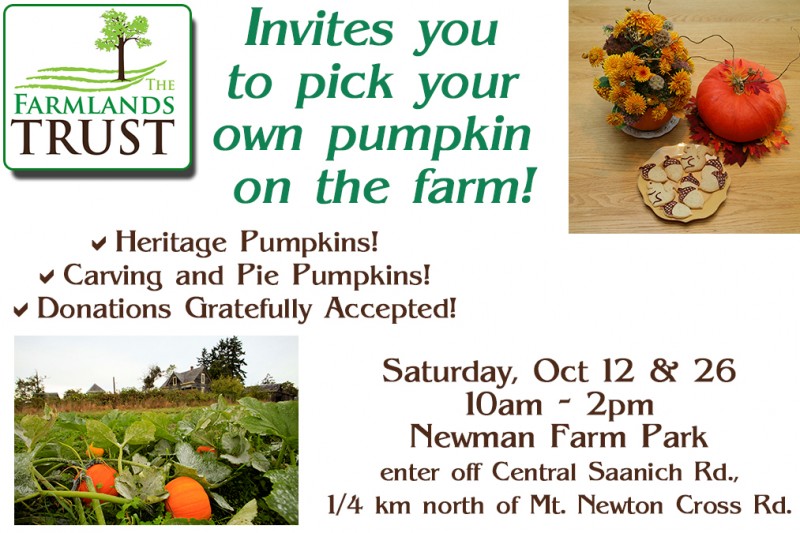Farm Produce Goes to (Soup) Pot
Newman Farm. Photo courtesy of Jennifer Brown
There is a lot of squash and zucchini soup being served downtown at “Our Place”, a society that provides meals and support services for Victoria’s poor and homeless. Each month, Our Place dishes out a whopping 36,000 meals to thousands of grateful recipients. To help make this possible, food is gathered weekly by truck from a variety of sources, including squash grown on the Saanich Peninsula by the Farmlands Trust (Greater Victoria) Society (FLT).
“Our main objective is to provide locally grown food for the folks that need it,” states Ed Johnson, Chair of the FLT Society, a local charity dedicated to preserving farmland and protecting local food security in Greater Victoria.
On average, 200 lbs per week of various squash and zucchini is currently being harvested by the FLT Society on their Newman Farm location in Central Saanich, with the help of volunteers and Our Place Society staff.
Food Services – Brian Cox
In late June 2013, they planted over 600 zucchini, squash and pumpkin plants that were grown from seed in Ed Johnson’s greenhouse. “I did not intend on having so many plants but the germination rate was so good, I was soon overwhelmed” said Johnson, who has been donating produce from his own garden, along with his neighbor Scott, to Our Place Society for the past four years.
Brian Cox, Food Services Manager for Our Place Society serves over 1,200 meals a day. He affirms that “It is important that people realize where their food comes from. Being local and fresh – it doesn’t get any better.”
During the week of September 9th, Brian Cox arrived at Newman Farm with Head Chef Dave Pickard to help with the harvesting. While 200 lbs of squash practically fills the bed of a pickup, Chef Pickard says they use it all within the week. “I put it through the grinder and add it to all sorts of recipes, from soups to sauces.”
For many city dwellers, Newman Farm is becoming an increasingly valuable food source, where on the Saanich Peninsula, Newman Farm is recognized as an important historical asset of Central Saanich.
The Newman Farm was in production for the last 100 years by the Newman Family, who farmed without municipal water or electricity. The District of Central Saanich obtained the property in 2003 through a family bequest.
District staff have concentrated most of their energy on the restoration of the Farm’s aging heritage buildings that include a house, several barns, a creamery and assorted outbuildings.
A memorial boathouse for John Newman is maintained by the Saanich Historical Artifacts Society. A large number of photographs and artifacts are on display depicting the life and times of the early twentieth century by the pioneering Newman family.
The FLT Society, with help of volunteers, are maintaining the Farm’s agricultural property, while producing food for those in need and improving the soil with organic methods.
The plan is to eventually invite the general public to a “farm park” where the historical legacy is integrated with current farming practices.
As part of a five year plan for Newman Farm, the FLT Society intends to further diversify the produce grown as time and volunteers permit. Collaboration with other like-minded groups with hands-on gardening and farming experience are in the works, to benefit marginalized people in Greater Victoria.
Following the bountiful squash and zucchini harvest at Newman Farm, there will be two dates in October where the public is invited to pick pumpkins, tour the farm, and by donation, pick from three varieties of heritage pumpkins which can be used for both carving and pies.
“Maybe we can even save some pumpkins for Gordie Dodd’s annual Thanksgiving dinner” says Johnson with a smile, who is always looking for new ways to help people with the upcoming harvest.

For more information, visit http://tinyurl.com/nwavfw9
Did you know? The Newman Farm seven hectare parcel is bisected by Central Saanich Road and the Pat Bay Highway. For several years, the portion from the highway to the Salish Sea has been open to the public. The original boathouses used by the Newman family was restored and are currently utilized as a canoe storage by Tsawout First Nation.
L-R: Ed Johnson, Chef Dave Pickard, Brian Cox. Photo by Natasha Caverley

















